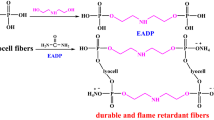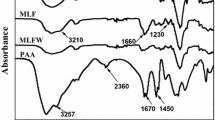Abstract
In this paper, a simple and facile polyol sorbitol was employed to design and synthesize a novel flame retardant containing phosphorus and nitrogen by the reaction of sorbitol with phosphoric acid and urea. The obtained sorbitol-based flame retardant was then used to treat lyocell fibers by a pad-dry-cure procedure. Formaldehyde and other harmful substances were not used during the preparation of flame retardant and modified fibers. For this strategy, only water is used as solvent, and the conditions are mild, safe and environmentally friendly. Fourier transform infrared spectroscopy and X-ray photoelectron spectroscopy analyses show that the sorbitol-based flame retardant was successfully grafted onto lyocell fibers. Scanning electron microscopy analyses show that the surface morphology of the treated fibers remained unchanged. Thermogravimetric analyses imply that the residue of the treated fibers increases considerably. Vertical combustion and limit oxygen index results indicate that the treated fibers possess excellent flame retardant and durable properties. Based on the results of pyrolysis gas chromatography–mass spectrometry, thermogravimetric-infrared and Raman spectroscopy, the flame retardant operates in condensed phase and gas phase during burning of treated fibers.















Similar content being viewed by others
References
Alongi J, Frache TA (2011) Hydrotalcite and nanometric silica as finishing additives to enhance the thermal stability and flame retardancy of cotton. Cellulose 18(1):179–190
Alongi J, Carletto RA, Di Blasio A, Carosio F, Bosco F, Malucelli G (2013a) DNA: a novel, green, natural flame retardant and suppressant for cotton. J Mater Chem A 1(15):36–40
Alongi J, Carletto RA, Di Blasio A, Carosio F, Bosco F, Malucelli G (2013b) DNA: a novel, green, natural flame retardant and suppressant for cotton. J Mater Chem A 1(15):4779–4785
Alongi J, Carosio F, Malucelli G (2014) Current emerging techniques to impart flame retardancy to fabrics: an overview. Polym Degrad Stab 106(8):138–149
Bai BC, Kim EA, Jeon YP, Lee CW, In SJ, Lee YS, Im JS (2014) Improved flame-retardant properties of lyocell fiber achieved by phosphorus compound. Mater Lett 135(12):226–228
Basak S, Samanta KK, Chattopadhyay SK, Narkar R (2015) Thermally stable cellulosic paper made using banana pseudostem sap, a wasted by-product. Cellulose 22(4):2767–2776
Chen L, Wang YZ (2010) A review on flame retardant technology in China. Part 1: development of flame retardants. Polym Adv Technol 21(1):1–26
Chen XL, Huo LL, Jiao CM, Li SX (2013) TG-FTIR characterization of volatile compounds from flame retardant polyurethane foams materials. J Anal Appl Pyrol 100(6):186–191
Deh S, Gähr F, Buchmeiser MR (2016) Synergistic effects in the pyrolysis of phosphorus-based flameretardants: the role of Si- and N-based compounds. Polym Degrad Stab 130:155–164
Dong YY, Gui Z, Hu Y, Wu Y, Jiang SH (2012) The influence of titanate nanotube on the improved thermal properties and the smoke suppression in poly(methyl methacrylate). J Hazard Mater 209–210(29):34–39
Dong CH, Lu Z, Zhang FJ, Zhu P, Wang P, Che Y, Sui SY (2016) Combustion behaviors of cotton fabrics treated by a novel nitrogen- and phosphorus-containing polysiloxane flame retardant. J Therm Anal Calorim 123(1):535–544
Gaan S, Rupper P, Salimova V, Heuberger M, Rabe S, Vogel F (2009) Thermal decomposition and burning behavior of cellulose treated with ethyl ester phosphoramidates: effect of alkyl substituent on nitrogen atom. Polym Degrad Stab 94(7):1125–1134
Gao WW, Zhang GX, Zhang FX (2015) Enhancement of flame retardancy of cotton fabrics by grafting a novel organic phosphorous-based flame retardant. Cellulose 22(4):2787–2796
Huang NH, Wang JQ (2009) A TGA-FTIR study on the effect of CaCO3 on the thermal degradation of EBA copolymer. J Anal Appl Pyrol 84(2):124–130
Jia YL, Hu YW, Zheng DD, Zhang GX, Zhang FX, Lianng YJ (2017) Synthesis and evaluation of an efficient, durable, and environmentally friendly flame retardant for cotton. Cellulose 24(2):1159–1170
Laufer G, Kirkland C, Morgan AB, Grunlan JC (2012) Intumescent multilayer nanocoating, made with renewable polyelectrolytes, for flame-retardant cotton. Biomacromolecules 13(9):2843–2848
Liang TY, Jiang ZL, Wang CS, Liu JL (2017) A facile one-step synthesis of flame-retardant coatings on cotton fabric via ultrasound irradiation. J Appl Polym Sci 134(30):45114–45120
Liu XH, Zhang QY, Cheng BW, Ren YL, Zhang YG, Ding C (2018a) Durable flame retardant cellulosic fibers modified with novel, facile and efficient phytic acid-based finishing agent. Cellulose 25:799–811
Liu XH, Zhang YG, Cheng BW, Ren YL, Zhang QY, Ding C, Peng B (2018b) Preparation of durable and flame retardant lyocell fibers by a one-pot chemical treatment. Cellulose 25(11):6745–6758
Mengal N, Syed U, Malik SA, Ali SI, Jeong SH (2016) Citric acid based durable and sustainable flame retardant treatment for lyocell fabric. Carbohydr Polym 153:78–88
Michałowski S, Hebda E, Pielichowski K (2017) Thermal stability and flammability of polyurethane foams chemically reinforced with POSS. J Therm Anal Calorim 130(1):155–163
Piskorz J, Radlein D, Scott DS (1986) On the mechanism of the rapid pyrolysis of cellulose. J Anal Appl Pyrol 9(2):121–137
Salmeia K, Gaan S, Malucelli G (2016) Recent advances for flame retardancy of textiles based on phosphorus chemistry. Polymers 8(9):319–355
Seddon H, Hall M, Horrocks AR (1996) The flame retardancy of lyocell fibres. Polym Degrad Stab 54(2):401–402
Szolnoki B, Bocz K, Marosi G, Toldy A (2016) Flame retardancy of sorbitol based bioepoxy via combined solid and gas phase action. Polymers 8(9):322
Toldy A, Niedermann P, Pomázi Á, Marosi G, Szolnoki B (2017) Flame retardancy of carbon fibre reinforced sorbitol based bioepoxy composites with phosphorus-containing additives. Materials 10(5):467–479
Vasiljević J, Jerman I, Jakša G, Alongi J, Malucelli G, Zorko M, Tomšič B, Simončič B (2015) Functionalization of cellulose fibres with DOPO-polysilsesquioxane flame retardant nanocoating. Cellulose 22(3):1893–1910
Wang X, Romero MQ, Zhang XQ, Wang R, Wang DY (2015) Intumescent multilayer hybrid coating for flame retardant cotton fabrics based on layer-by-layer assembly and sol-gel process. RSC Adv 5(14):10647–10655
Wang LH, Ren YL, Wang XL, Zhao JY, Zhang Y, Zeng Q, Gu YT (2016) Fire retardant viscose fiber fabric produced by graft polymerization of phosphorus and nitrogen-containing monomer. Cellulose 23:2689–2700
Wu TK (1980) Carbon-13 and proton nuclear magnetic resonance studies of cellulose nitrates. Nature 13(1):552–555
**e K, Gao A, Zhang Y (2013) Flame retardant finishing of cotton fabric based on synergistic compounds containing boron and nitrogen. Carbohydr Polym 98(1):706–710
Xue CH, Zhang L, Wei P, Jia ST (2016) Fabrication of superhydrophobic cotton textiles with flame retardancy. Cellulose 23(2):1471–1480
Yang CQ, He QL, Lyon RE, Hu Y (2010) Investigation of the flammability of different textile fabrics using micro-scale combustion calorimetry. Polym Degrad Stab 95(2):108–115
Yoshioka-Tarver M, Condon BD, Cintrón MS, Chang SC, Easson MW, Fortier CA, Madison A, Bland JM, Nguyen TMD (2012) Enhanced flame retardant property of fiber reactive halogen-free organophosphonate. Ind Eng Chem Res 51(34):11031–11037
Yurkshtovich NK, Yurkshtovich TL, Kaputskii FN, Golub NV, Kosterova RI (2007) Esterification of viscose fibres with orthophosphoric acid and study of their physicochemical and mechanical properties. Fibre Chem 39(1):31–36
Zarif L, Greiner J, Riess JG (1989) Perfluoroalkylated monoesters of 1,4-D-sorbitan, isosorbide and isomannide: new surfactants for biomedical applications. J Fluor Chem 44(1):73–85
Zheng DD, Zhou JF, Zhong L, Zhang FX, Zhang GX (2016) A novel durable and high-phosphorous-containing flame retardant for cotton fabrics. Cellulose 23(3):2211–2220
Acknowledgments
The authors are very thankful for the financial support provided by the National Key Research and Development Program of China (No. 2017YFB0309000).
Author information
Authors and Affiliations
Corresponding authors
Additional information
Publisher's Note
Springer Nature remains neutral with regard to jurisdictional claims in published maps and institutional affiliations.
Rights and permissions
About this article
Cite this article
Liu, Xh., Ding, C., Peng, B. et al. Synthesis and application of a new, facile, and efficient sorbitol-based finishing agent for durable and flame retardant lyocell fibers. Cellulose 27, 3427–3442 (2020). https://doi.org/10.1007/s10570-019-02894-z
Received:
Accepted:
Published:
Issue Date:
DOI: https://doi.org/10.1007/s10570-019-02894-z




